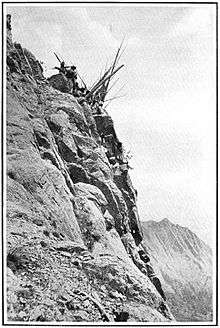Syed Muhammad Masood
| Mir | میر Syed Muhammad Masood (Arabic: السيد محمد مسعود) Forefather of Mashwanis | جد امجد مشوانین | |
|---|---|
 | |
| Born |
462 AH | 1069 AD Basra Ishan al Mashwan |
| Died | 526 AH | 1131 AD |
| Resting place | Sulaiman Mountains |
| Known for | Progenitor of Arab origin Pukhtuns tribes including Mashwanis, Ludin and Roghanis. |
| Title | Mir, Meer |
| Movement | Zayd ibn Ali Revolution |
| Spouse(s) | Sher Bano Kakri |
| Children |
Syed Abdul Ghafoor (Son), Syed Allauddin (Son) Syed Adam (Son) Syed Badruddin (Son) |
| Parent(s) |
Syed Muhammad Zafar (Father) Bano Kakri (Mother) |
| Relatives |
Syed Abdul Sattar (Brother) Syed Muhammad Haani (Brother) |
Syed Muhammad Masood (Arabic: السيد محمد مسعود) (Urdu: سید محمد مسعود) was the progenitor of Mashwanis tribe. He was the great grandson of Gesudaraz I[3][4][5] and his spouse was Bano, the daughter of Kakar Commander of that times.[4] He born to Syed Muhammad Zafar in 462 AH. 1069 CE[5][4] He left for Ishan al Mashwan and later he sided from Ishan al Mashwan Basra, and setteled among Osh. He is progenitor of Saveral Sayyid tribes in Afghanistan, Pakistan, Iran and Middle East.[6][7][8][9][10][11][12][13][14][15][16]
Indigenous historians have mistakenly used his name “Syed Muhmmad” for his great-grand father Gesudaraz I who never had married to any Afghan woman. Also some historians mistakenly said that he is the direct descendant of his great-grandfather and named him “Mashwani” made stories for his name which are totally rejected by family tree researchers. His decendants are called “Mashwani” due to he belongs from Ishan al Mashwan Basra.[4]
References
- ↑ "tareekh e afaghina syed zuhuurul hasan ebooks سید ظہور الحسن | ریختہ". Rekhta (in Urdu). Retrieved 2018-09-23.
- ↑ افغانی, عبد الحلیم اثر. "روحانی رابطہ او روحانی تړون، پښتو - Maktabah Mujaddidiyah". Retrieved 2018-09-23.
- ↑ خٹک, استاد افضل خان. تاریخ مرصع.
- 1 2 3 4 الحسيني, مير سيد ثاقب عماد. "ابحاث و تشریح در مشجرات السادات افاغنہ". سادات رسول ص در افاغنہ.
- 1 2 بنوري, قطب الاقطاب شيخ سيد آدم. نكات الاسرار. الهند: سر هند.
- ↑ Shah, Syed Yousaf (1930). حالات مشوانی. Lahore: Muhammadi Press. pp. 20–26.
- ↑ NimatUllah خواجہ خواجہ نعمت اللہ ہروی (1613). تاریخ خان جھانی مخزن افغانی Tarikh-i-khan jahani wa makhzan-i-Afghani (PDF). pp. 648–649.
- ↑ Dorn, Bernhard (1829). History of the Afghans (2 ed.). p. 56-57.
- ↑ Henry, Walter Bellew (1862). Journal of a Political Mission to Afghanistan in 1857, Under Major Lumsden: With an Account of the Country and People. National Library of the Netherlands: Elder Smith, 1862.
- ↑ Balfour, Edward (1885). The Cyclopædia of India and of Eastern and Southern Asia: Commercial, Industrial and Scientific, Products of the Mineral, Vegetable, and Animal Kingdoms, Useful Arts and Manufactures, Volume 2. India: B. Quartitch, 1885. p. 215.
- ↑ کرمانی, شاہ عطااللہ. روضہ الاحباب.
- ↑ Gandapur, Sher Muhammad Khan (1894). تواریخ خورشید جھاں. Lahore: Islamiya Kutab. pp. 275–309.
- ↑ Khān, Muḥammad Ḥayāt (1981). Afghanistan and Its Inhabitants. Sang-e-Meel Publications.
- ↑ Bellew, Henry Walter (1862). Journal of a Political Mission to Afghanistan, in ,1857 Under Major (now Colonel) Lumsden: With an Account of the Country and People. Orient Research Centre.
- ↑ (Pakistan), Baluchistan (1907). Baluchistan District Gazetteer Series: Quetta-Pishin. printed at Bombay Education Society's Press.
- ↑ Khalil, Malik Muhammad. Tribe Khalil & The Brighten Persons Of Khalil: Tribe Khalil, famous people of tribe khalil (in Arabic). AttaUrRehman.